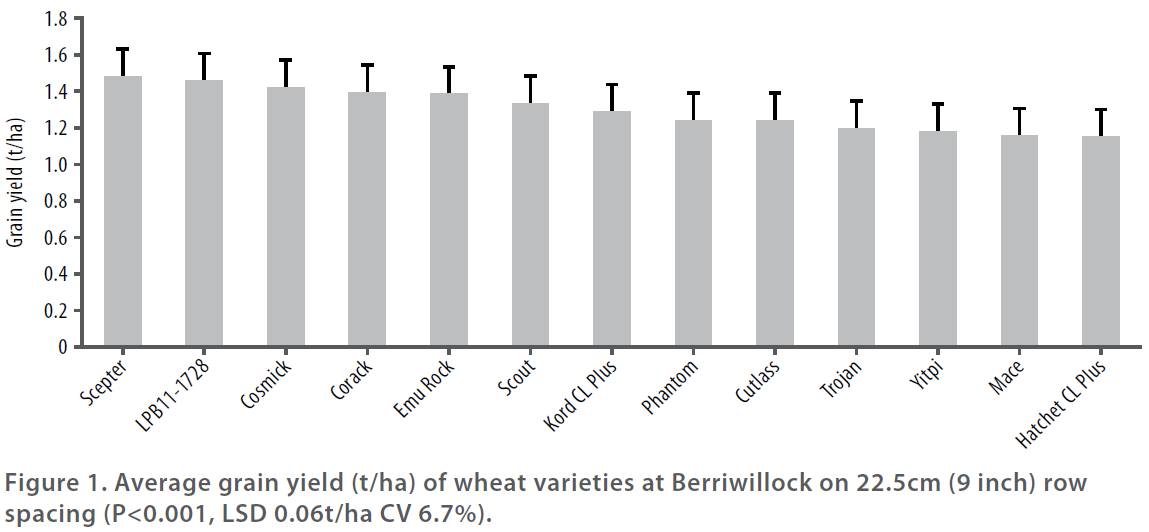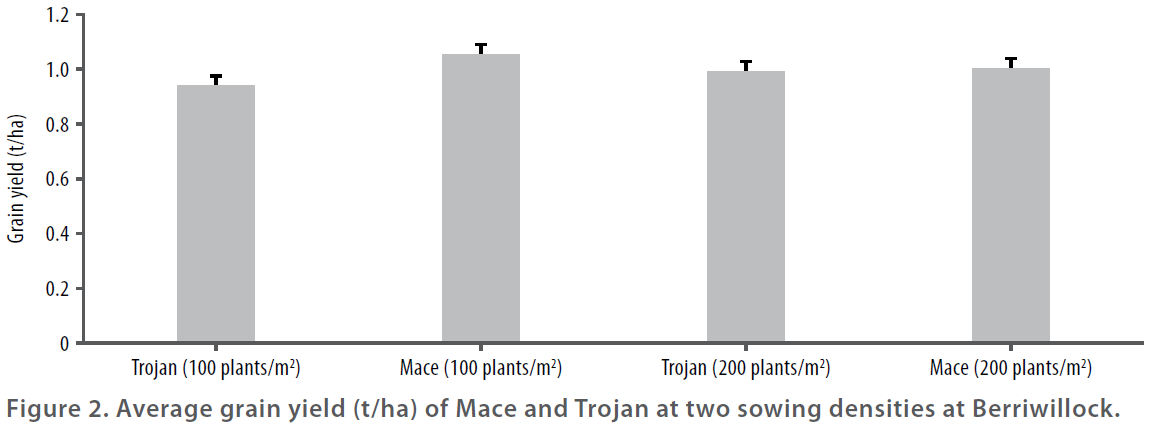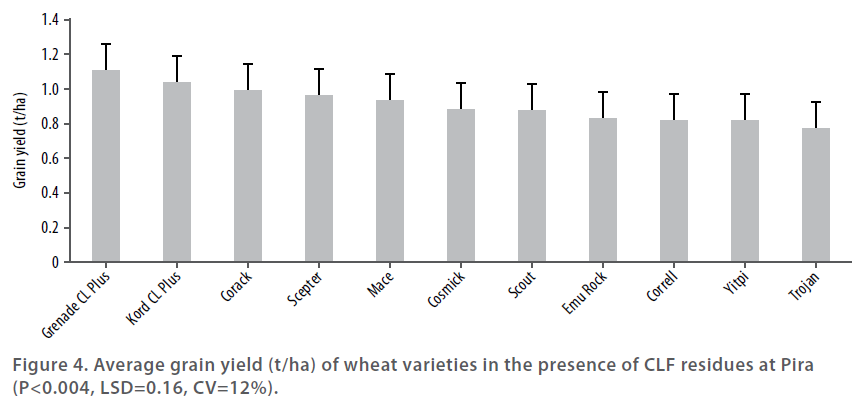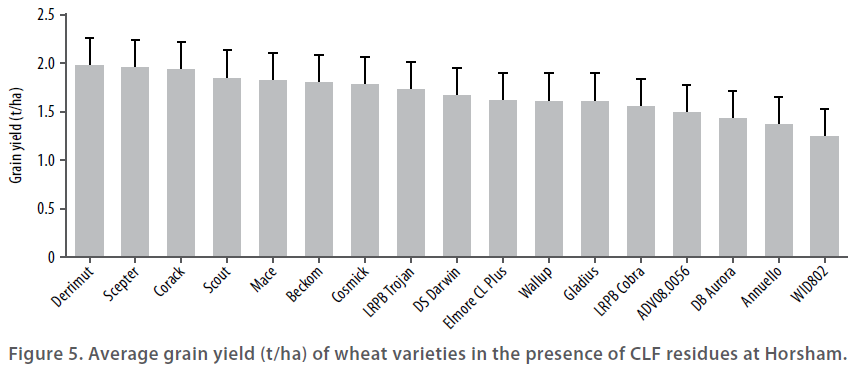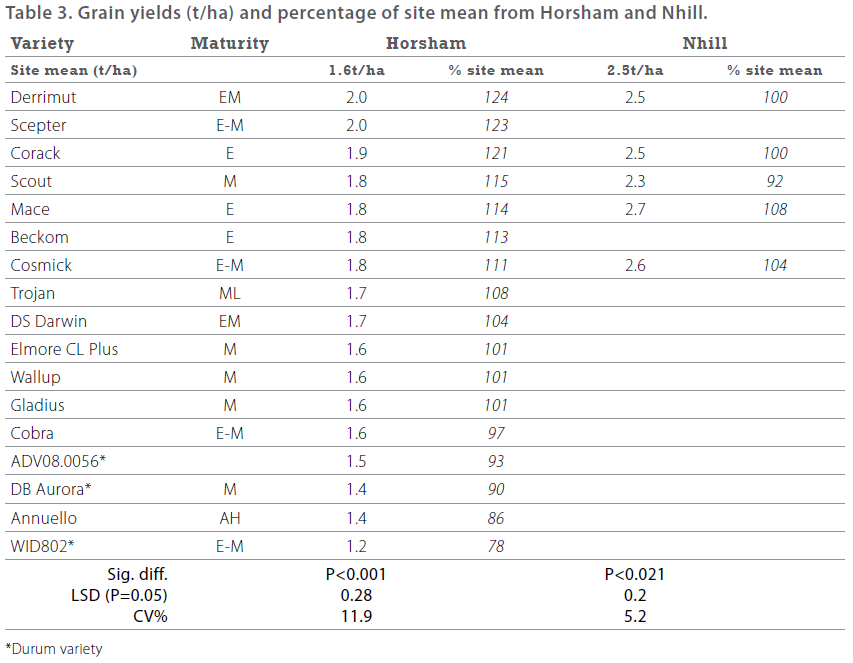Wheat varieties were truly tested this year, as many areas of the Wimmera and Mallee experienced a frosty, dry year with little to no soil moisture. Unfortunately, it is during these years that growers get to truly test newly adopted varieties for their suitability to the region. It should be remembered that management practices, such as time of sowing/emergence, nutrition, weed and disease control, crop rotations/sequences and soil type can all influence crop yield and quality.
Each year, BCG conducts variety trials and investigates the ways in which certain varieties respond to key management practices. This article will summarise the performance of new and current wheat varieties in BCG trials and incorporated NVT trials for 2015 season. The influence of row spacings will also be discussed. Some of these trials were monitored for changes in stubble characteristics of different varieties.
TAKE HOME MESSAGES
- Scepter was the highest yielding variety (or equal highest) at Berriwillock, Quambatook and
Pira (based on one year of data only). - Earlier maturing varieties such as Corack, Mace, Derrimut and Hatchet CL Plus tended to be
higher-yielding than later maturing varieties. - In Mallee National Variety Trials (NVT) Corack, Mace, Cosmick and Shield have been higher
than the site mean for the last five years. - When averaged over the last five years, Mace, Corack, Cosmick, Scout and Derrimut have
yielded better than the site mean in Wimmera NVTs.
AIM
To compare the performance of new and existing wheat varieties in the Wimmera and Mallee and to investigate the influence of row spacing, variety maturity and plant density on crop performance (Berriwillock site only).
Pests, weeds and diseases were controlled to best management practice in all of these trials.
A wheat variety trial was also sown at Horsham (see ‘Wheat sowing time: finding an adaptable variety’, pp. 64).
METHOD
Replicated trials were established at Quambatook, Pira, Horsham and Nhill using a complete
randomised block design. Assessments included establishment counts, NDVI (measure of canopy greenness), grain yield and quality parameters. The Quambatook trial also included proposed disease treatments, but when no diseases emerged during the season this was abandoned.
At the Berriwillock site, a split plot design was used. Mace and Trojan, which are two similar yielding varieties with different maturities, were sown on three different row spacings: 22.5cm (9 inch), 30cm (12 inch) and 38cm (15 inch) and at two plant densities: 100 plants/m2 and 200 plants/m2. Thirteen additional varieties were also sown each on 22.5cm and 38cm row spacings. The trial was dry-sown into a vetch hay stubble on May 15. A 13mm fall, which occurred five days after sowing, resulted in good, even emergence across the trial.
Grain yield was measured and quality (protein, moisture, test weight and screenings) analysis was performed according to grain receival site standards. Statistical analysis was completed using a one way and or a two-way ANOVA in Genstat, depending on the trial design.
RESULTS AND INTERPRETATION
BERRIWILLOCK
The highest yielding varieties at Berriwillock were Scepter, LPB11-1728, Cosmick, Corack, Emu Rock and Scout (Table 2). Mace was lower yielding than it was in previous years.
During the season the temperature fell below zero degrees at canopy height on 37 days. However the majority of these frosts occurred prior to grain filling.
Plots sown on narrower row spacings (22.5cm) were higher yielding than those sown on wider (38cm) row spacing (Figure 1). While there were differences between varieties and between row spacings, no variety was suited to a particular row spacing. Figure 1 below shows the yields of each variety (22.5cm data is presented only).
High protein was observed in all varieties due to the site having adequate N and low yield potential due to the dry season. There were no significant differences between protein per cent in any varieties, which was also the case for test weight (kg/hL). Screenings were all under 12% in this trial, and a difference between varieties was observed. The mean quality grade achieved was AGP (largely due to the test weight and, in a few cases, screenings which were greater than 10%. Mace and Cutlass had the lowest screenings of all varieties (P=0.04, LSD 3.6, CV 36%). LPB11-1728 is a variety predicted to be released soon; it is of AH quality and has good yellow spot leaf (YLS) characteristics.
Mace and Trojan were compared at three different row spacings and two plant densities. The data showed a trend that suggested that narrower row spacing yielded more than wider row spacings but this was not significant (P=0.061, CV 6.7%). Reflecting the dry season, Mace sown at 100 plants/m2 yielded higher than Mace sown at 200 plants/m2 (Figure 2).
QUAMBATOOK
The trial at Quambatook was dry-sown into field pea stubble on May 11, (similar to Berriwillock), and a dry seed bed. Eight days later the site received 12mm of rain which stimulated germination and as a result, establishment at the site was good.
Throughout the season the trial looked reasonable, despite having received only 150mm of growing season rainfall by the end of September. The mean yield in this trial is 1t/ha, which is reflective of the yield reports from local growers. The trial site received rain during October, which caused some regrowth in secondary tillers, in turn delaying the timing of harvest.
Scepter, Hatchet CL Plus, Mace and LPB11-1728 were the highest-yielding varieties at the site (Figure 3). Of particular note is the variation in the maturities of these four varieties. One is very early (Hatchet CL Plus), two are early-mid (Scepter and Mace) and one is mid-late maturity (LPB11-1728). Anecdotally, early maturing varieties tend to perform better in drier seasons. This was also observed in 2014 NVT analysis 2014 BCG Season research results, pp 55-64).
It was noted that just prior to harvest, Cutlass had a few heads with minimal grain in the top half of the head. This may explain the reason behind its lower yield.
Mid- to late-maturing varieties such as Yitpi and Trojan may have been penalised due to the dry and hot spring. Grain protein was varied with Scepter, Scout and Grenade CL Plus having protein just below 13 per cent, the minimum for H1. However, they did achieve a H2 grading.
Trojan and Corack were the only two varieties with a test weight (kg/hL) sufficiently high to achieve H1. Because of high screenings, most varieties were graded AGP.
PIRA – CEARFIELD TOLERANCE TRIAL
The Pira site was sown on 21 May into a wheat stubble and emerged well. The trial had imidazoline herbicide residues from 2014 present in the soil. In July 2014 the paddock had Velocity® at 1L/ha and MCPA LVE at 700mL/ha. In a separate spray the paddock had Midas® at 20g/ha. The 2014 dry spring made this site perfect for examining the tolerance of varieties to herbicide residues. During the 14/15 summer the site also received no rain.
In a dry season, Grenade CL Plus, Kord CL Plus, Corack and Scepter (Figure 4) were the highest yielding varieties in the presence of Clearfield residue. There was a 0.3t/ha difference between the Grenade CL Plus and varieties such as Trojan, Yitpi and Correll. Much lower differences were observed in other varieties such as Corack and Scepter (0.1t/ha).
Although chemical residue issues exist following below average rainfall between seasons, the differences observed in this trial would be much greater when the yield potential is higher. Yield loss would also be much greater on different soil types such as limestone soils. Although yield losses in this trial were relatively small, they still represent a 10-30 per cent penalty when compared with CLF varieties. In the absence of herbicide these varieties could have achieved an additional five per cent yield.
HORSHAM
The Horsham site had 17 varieties sown at two times of sowing (TOS). All the data presented is from TOS1. The trial sown dry on May 18 received 5mm that night and 2mm the following day. Adequate soil N in the fallow at Horsham, meant the trial was not top-dressed. The trial achieved a yield of 2t/ha in some varieties; an interesting result given that there was 118mm of GSR. The three Durum varieties ADV08.0056, DB Aurora and WID802 performed equal to Gladius and Cobra (Figure 5).
NHILL
The trial at Nhill was sown on May 23 with the intention of applying fungicides at different timings during the season. Low disease pressure meant that only the control treatments are presented here. This trial was sown into a fallow paddock with 22mm of plant available water. As a result, establishment was even across the site. At GS30, when Normalised Difference Vegetation Index (NDVI) measurements were taken there were no differences between the five varieties.
Yield results from Nhill were typically higher than those experienced in the region. The site average was 2.5t/ha. Mace, Cosmick and Corack were the highest yielding varieties with Scout only fractionally less than the others (Figure 6). Screenings were all below seven per cent at the site. Cosmick was the only variety with over five per cent screenings. This result was mirrored at Quambatook and Berriwillock.
NVT RESULTS
NVT results from the Mallee (2011-2015) have been averaged and the percentage of site mean compared with their performance in 2015 (Figure 7). Cosmick, Corack, Mace, Shield, Emu Rock and Correll all yielded better than the trial site mean for the last five years. Shield and Emu Rock, both early maturing varieties, performed better this year than they have on average over the past five years. Note: Correll was not in the NVT trials in 2015.
In the Wimmera, Corack, Mace, Cosmick, Scout and Derrimut all performed as well as, or better than, the site mean over the last five years (Figure 8). This reiterates that early maturing varieties tended to perform better in 2015. At Horsham and Minyip sites Correll yields were considerably lower than those of other varieties in 2015.
See Appendix 3, BCG 2015 SSR – Appendix 3.
COMMERCIAL PRACTICE
It is important when choosing a variety to take into account the varieties agronomic package and how it would fit into the system. Growing varieties with different maturity groups, with staggered flowering dates, can certainly help reduce risk in the event of frost or heat shock. Another option is to sow the selected varieties as early as possible within their flowering window. Based on the results from the last few seasons, it is well worth having an early maturating variety in the system in the event of a dry spring or the season finishing earlier than anticipated.
These trials were intended to be a variety summation from different regions and to make comparisons over a few seasons to assist growers in making variety decisions. While the 2015 season was far from favourable, it was a good year to see which varieties perform well in a dry year. Even in decile 1 seasons, there are still findings that can inform future practices.
The row spacing by variety trial looked to identify whether certain varieties were more suited to a particular row spacing. The results from Berriwillock highlighted that no specific varieties were more suited to one particular spacing.
2015 also confirmed the risks associated with herbicide residues. There was a penalty of 10 to 30 per cent for sowing a conventional wheat variety over a CLF tolerant variety when residual herbicides were present. This highlights the importance of keeping good herbicide and rainfall records.
ON-FARM PROFITABILITY
Using the results from BCG trials in 2015, Scepter yielded 0.3t/ha more than Mace, which resulted in an extra $81.50/ha in profit from the additional yield (Berriwillock grain price $271.90 at 19 November 2015). The results from the Quambatook trial site, when comparing Mace with Scout, resulted in an additional 0.2t/ha which equates to $46.76/ha in additional grain income (using the Quambatook AGP1 price).
Varietal changes may only increase yield by two to five per cent, and in some cases the yield gain may not be enough to warrant switching varieties. However, if you are looking for something new or a variety has not performed as well as you had anticipated a change may be the way to go. Just remember, the design of these trials is intended to identify small differences and when comparing the varieties on the farm, the disparity may be less pronounced. Generally, growing a variety with less than 10 per cent yield increase over two to three seasons from small plot trials has insignificant implications for changes in profitability.
REFERENCES
Victorian Winter Crop Summary 2015, Department of Economic Development, Jobs, Transport and Resources (DEDJTR).
ACKNOWLEDGEMENTS
This research was funded by GRDC as part of the ‘Maintaining profitable farming systems in retained stubble’ project (BWD00024).

